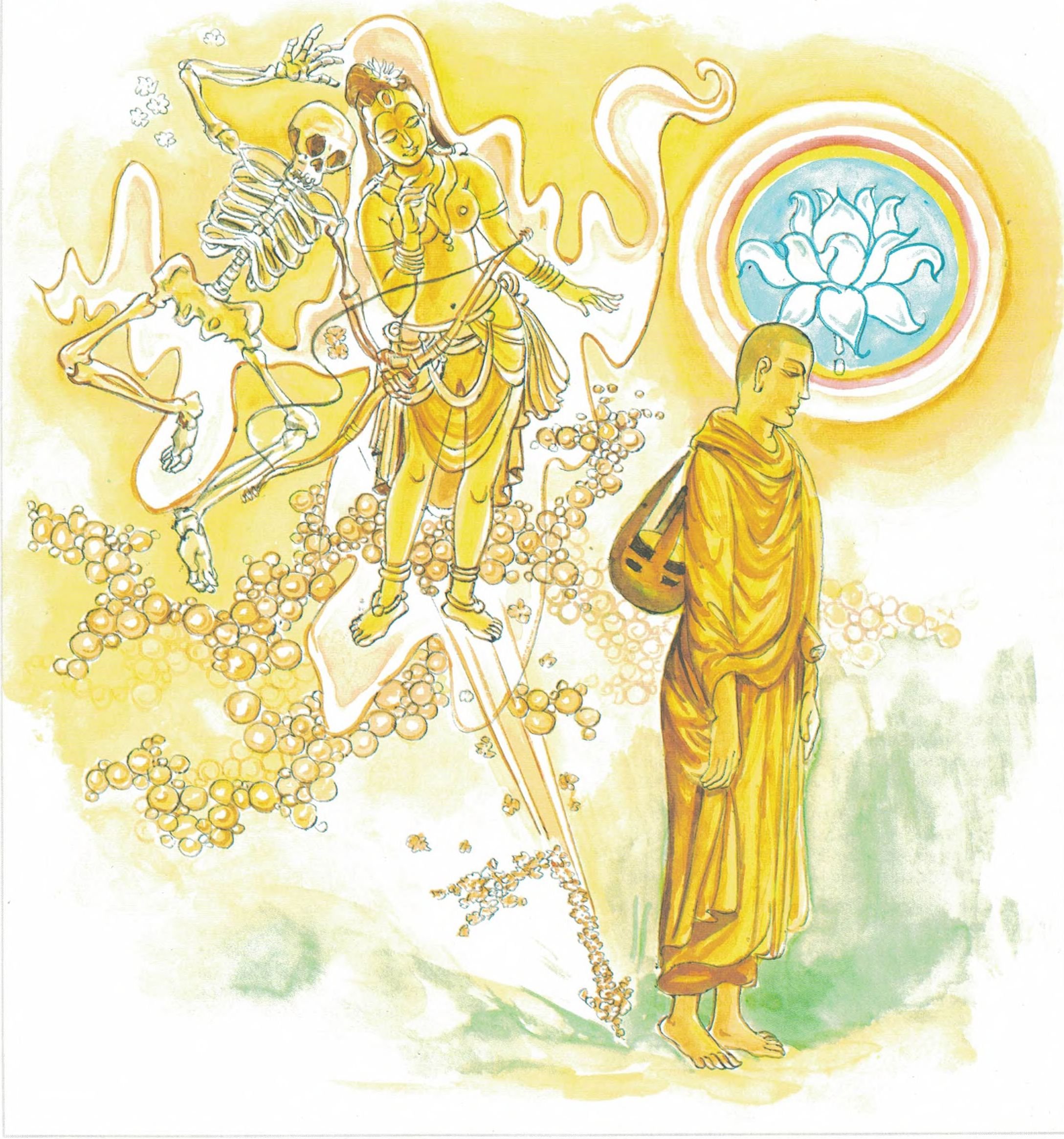Dhammapada (Illustrated)
by Ven. Weagoda Sarada Maha Thero | 1993 | 341,201 words | ISBN-10: 9810049382 | ISBN-13: 9789810049386
This page describes The Story of the Monk who Contemplates The Body as a Mirage which is verse 46 of the English translation of the Dhammapada which forms a part of the Sutta Pitaka of the Buddhist canon of literature. Presenting the fundamental basics of the Buddhist way of life, the Dhammapada is a collection of 423 stanzas. This verse 46 is part of the Puppha Vagga (Flowers) and the moral of the story is “Viewing this body as foam and a mirage, one avoids the shafts of death and goes beyond him”.
Verse 46 - The Story of the Monk who Contemplates The Body as a Mirage
Pali text, illustration and English translation of Dhammapada verse 46:
pheṇūpamaṃ kāyam'imaṃ viditvā marīcidhammaṃ abhisambudhāno |
chetvāna mārassa papupphakāni adassanaṃ maccurājassa gacche || 46 ||
46. Having known this froth-like body and wakening to its mirage-nature, smashing Māra’s flowered shafts unseen beyond the Death-king go.
 Viewing this body as foam and a mirage, one avoids the shafts of death and goes beyond him. |
The Story of the Monk who Contemplates The Body as a Mirage
While residing at the Jetavana Monastery, the Buddha spoke this Verse, with reference to a certain monk.
A monk obtained a meditation topic from the Buddha and entered the forest for the purpose of practising meditation. But when, after striving and struggling with might and main, he was unable to attain arahatship, he said to himself, “I will ask the Buddha to give me a meditation topic that better suits my needs.” With this thought in mind he set out to return to the Buddha.
On the way he saw a mirage. He said to himself, “Even as this mirage, as seen in the season of the heat, appears substantial to those that are far off, but vanishes on nearer approach, so also is this existence unsubstantial by reason of birth and decay.” Upon fixing his mind on the mirage, he meditated on the mirage. On his return, wearied with the journey, he bathed in the Aciravati River and seated himself in the shade of a tree on the river bank near a waterfall. As he sat there watching the white water bursting from the force of the water striking against the rocks, he said to himself, “Just as this existence produced and just so does it burst.” And this he took for his meditation topic.
The Buddha, seated in his perfumed chamber, saw the elder and said, “Monk, it is even so. Like a bubble of foam or a mirage is this existence. Precisely thus is it produced and precisely thus does it pass away.” And when He had thus spoken the Buddha pronounced the stanza.
Explanatory Translation (Verse 46)
imaṃ kāyaṃ pheṇūpamaṃ viditvā marīci dhammaṃ abhisambudhāno
mārassa papupphakāni chetvāna maccurājassa adassanaṃ gacche
imaṃ: this; kāyaṃ [kāya]: body; pheṇūpamaṃ [pheṇūpama]: is like froth; viditvā: knowing; marīci dhammaṃ [dhamma]: is also like a mirage; abhisambudhāno [abhisambudhāna]: understanding fully; Mārassa: belonging to Death; papupphakāni: the flower arrows; chetvāna: destroying; maccurājassa: of king-death; adassanaṃ [adassana]: beyond the vision; gacche: make your way.
This body of ours is like froth, a bubble, or foam. It disintegrates quickly. The nature of life is like a mirage, an illusion. Therefore, one must give up these unrealities. To achieve that one must destroy Māra’s flower-arrows by which he tempts men and women. It is necessary that the truth-seeker should go beyond Māra’s region, to areas unseen by him. Māra knows only the realm of death. The truth seeker goes beyond that region to the ‘deathless’ (Nibbāna)–a domain Māra has never seen.
Commentary and exegetical material (Verse 46)
pheṇūpamaṃ: like froth. The body is compared to froth and bubble, because the body too disintegrates quickly like froth and bubble. In many instances, the transience of the human body is equated to the disintegration of a bubble.
marīci dhammaṃ abhisambudhāno: becoming deeply aware of the mirage-like insubstantiality and the illusory nature of life. The bubble and the mirage, together emphasize the evanescence and the illusory nature of life.
kāya: literally means ‘Group’, ‘Body’. It may either refer to the physical body or to the mental body. In the latter case it is either a collective name for the four mental groups (feeling, perception, mental formations, consciousness) or merely for feeling, perception and a few of the mental formations. Kāya has this same meaning in the stereotype description of the third absorption “and he feels joy in his mind or his mental constitution, and of the attainment of the eight deliverance; “having attained the eight deliverance in his mind, or his person”. Kāya is also the fifth sense-organ, the body-organ.
marīci Dhammaṃ: the nature of a Mirage. Dhamma has many connotations. It literally means the ‘Bearer’, Constitution (or Nature of a thing) Norm, Law, Doctrine; Justice, Righteousness; Quality; Thing, Object of Mind; ‘Phenomenon’. In all these meanings the word ‘dhamma’ is to be met with in the texts. The Comment to Dhammapada gives four applications of this term: quality, virtue, instruction, text, soullessness, e.g. “all dhamma, phenomena, are impersonal etc.”. The traditional Comment has hetu (condition) instead of desanā. Thus, the analytical knowledge of the Law is explained as knowledge of the condition. The Dhamma, as the liberating law, discovered and proclaimed by the Buddha, is summed up in the Four Noble Truths. It forms one of the three Gems and one of the ten Recollections.
Dhamma, as object of mind, may be anything past, present or future, corporeal or mental, conditioned or not, real or imaginary.
